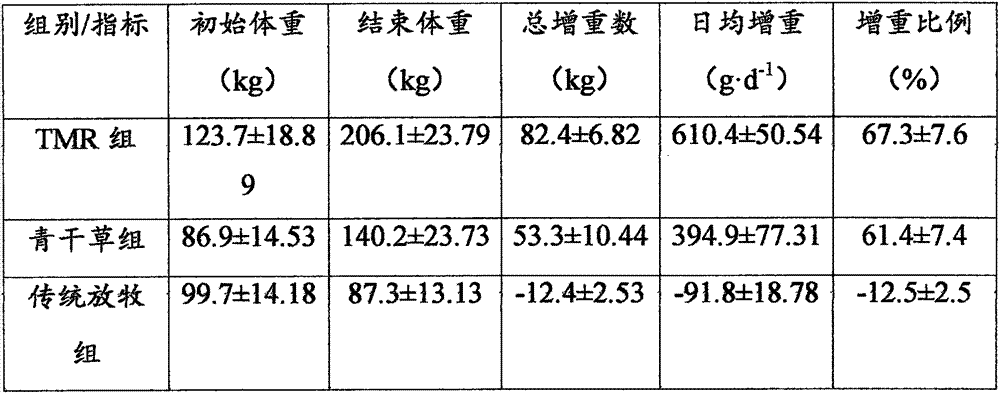TMR daily ration for improving productivity of yaks in cold seasons, and feeding method thereof
A production performance and yak technology, applied in the field of animal husbandry, can solve the problems of low nutrient content of oat hay, inaccurate feed mix, and poor supplementary feeding effect, so as to promote the growth of yaks, increase feed intake and utilization rate of forage resources , the effect of reducing energy consumption
- Summary
- Abstract
- Description
- Claims
- Application Information
AI Technical Summary
Problems solved by technology
Method used
Image
Examples
Embodiment 1
[0023] A TMR diet and feeding method for improving the production performance of yaks in the cold season. The TMR diet consists of 120 parts of green hay, 100 parts of basic concentrate, 2 parts of premix, and 80 parts of water. The main raw materials of the basic concentrate are corn, wheat, highland barley, bran, bean dregs, calcium hydrogen phosphate, sodium hydrogen phosphate, rock powder, salt, etc. The guaranteed value of the component analysis of the concentrate nutrition is dry matter ≥ 86%. Protein ≥ 14%, crude fiber ≤ 8.8%, crude ash ≤ 7.0%, salt 0.3-0.9%, calcium 0.6-1.2%, phosphorus ≥ 0.6%. The main raw materials of the premix are feed vitamins, trace elements, amino acids, calcium, phosphorus, magnesium and NSP enzymes, etc., are packaged in a 2% dosage form, and are matched with feed at a ratio of 1:50. The green hay is the forage harvested in the same year, and it is stored in a dry and ventilated manner. It is forbidden to use expired moldy green hay to prepare...
Embodiment 2
[0027] Example 2 uses the feed component detection technology to compare the nutritional components of the TMR diet of the present invention and green hay, and the results are shown in Table 1.
[0028] Table 1
[0029]
[0030] It can be seen from Table 1 that the crude protein and crude fat content of the TMR ration prepared in this example is higher than that of green oat hay, while the indigestible fiber content is lower than that of green oat hay.
Embodiment 3
[0032] From December 15, 2014 to May 1, 2015, a 135-day fattening experiment was conducted in Guinan Modern Grass Industry Development Co., Ltd., Qinghai Province. The experiment was divided into three groups: TMR group; green hay group; traditional grazing group. To verify the beneficial effects of the present invention.
[0033] Table 2 shows the feed intake and breeding costs of the TMR group and the green hay group (the traditional grazing group is produced by free grazing in the cold season).
[0034] Table 2
[0035]
[0036] It can be seen that the average daily feed intake (DMI) of yaks in the TMR group was 5.19kg / head / d, and the fattening cost was 1205.1 yuan; the average daily feed intake (DMI) of yaks in the green hay group was 4.08kg / head / d, and the fattening cost was 754.6 yuan Yuan, in order to further illustrate the beneficial effect of the present invention, we have carried out the production performance index of cold-season yak and carried out statistics. ...
PUM
 Login to View More
Login to View More Abstract
Description
Claims
Application Information
 Login to View More
Login to View More - R&D
- Intellectual Property
- Life Sciences
- Materials
- Tech Scout
- Unparalleled Data Quality
- Higher Quality Content
- 60% Fewer Hallucinations
Browse by: Latest US Patents, China's latest patents, Technical Efficacy Thesaurus, Application Domain, Technology Topic, Popular Technical Reports.
© 2025 PatSnap. All rights reserved.Legal|Privacy policy|Modern Slavery Act Transparency Statement|Sitemap|About US| Contact US: help@patsnap.com



